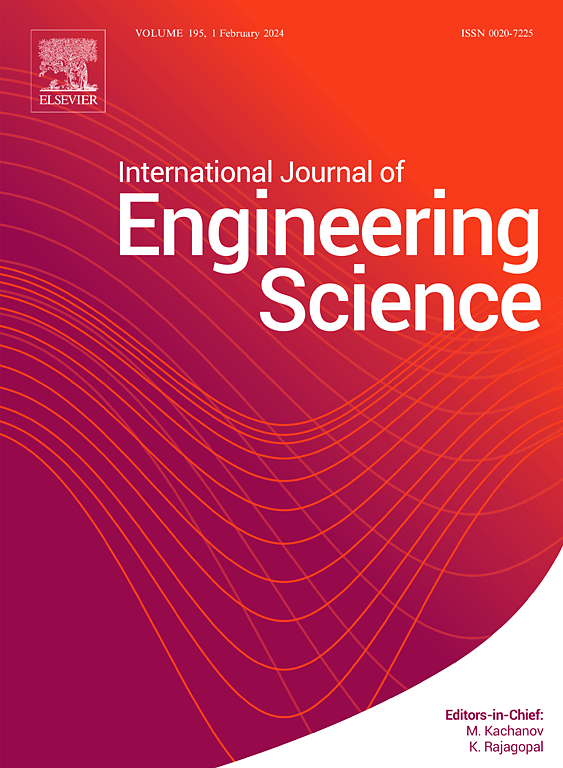Capillary force on the inner wall of the mesh atomizer influencing the size of the droplets
IF 5.7
1区 工程技术
Q1 ENGINEERING, MULTIDISCIPLINARY
International Journal of Engineering Science
Pub Date : 2025-10-16
DOI:10.1016/j.ijengsci.2025.104399
引用次数: 0
Abstract
Piezoelectric atomizer is widely used in inhalation therapy field, where the drug deposition depth depends on the size of the atomized droplet. Herein, the diameter of the droplet was regulated by changing the wettability of the inner wall of the tapered hole of atomizers. The dynamic cone angle-capillary (DCA-C) model is established, where the contact angle of the inner wall θ and the cone angle α are the two key parameters to influence of the droplet size. When θ>π/2+α/2, the droplet size decreases; when θ<π/2+α/2, the droplet size increases. The experiment results show that after non-wetting treatment of the metal sheet of the atomizer, the contact angle θ=162°, and the atomized droplet diameter is 1.246 μm, which is decreased by 83.9%; after wetting treatment, the contact angle θ=66°, and the atomized droplet diameter is 9.851 μm, which is increased by 27.3%. It demonstrates that the DCA-C model can better explain the mechanism of piezoelectric atomization, where the capillary force plays a crucial role in regulating droplet size.
网状雾化器内壁毛细力对雾滴大小的影响
压电雾化器广泛应用于吸入治疗领域,其药物沉积深度取决于雾化液滴的大小。本文通过改变喷嘴锥形孔内壁的润湿性来调节液滴的直径。建立了动态锥角-毛细管(DCA-C)模型,其中内壁接触角θ和锥角α是影响液滴大小的两个关键参数。当θ>;π/2+α/2时,液滴尺寸减小;当θ<;π/2+α/2时,液滴尺寸增大。实验结果表明:对雾化器金属板进行非润湿处理后,接触角θ=162°,雾化液滴直径为1.246 μm,减小了83.9%;润湿处理后,接触角θ=66°,雾化液滴直径为9.851 μm,增大27.3%。结果表明,DCA-C模型能较好地解释压电雾化的机理,其中毛细力对液滴大小的调节起着至关重要的作用。
本文章由计算机程序翻译,如有差异,请以英文原文为准。
求助全文
约1分钟内获得全文
求助全文
来源期刊

International Journal of Engineering Science
工程技术-工程:综合
CiteScore
11.80
自引率
16.70%
发文量
86
审稿时长
45 days
期刊介绍:
The International Journal of Engineering Science is not limited to a specific aspect of science and engineering but is instead devoted to a wide range of subfields in the engineering sciences. While it encourages a broad spectrum of contribution in the engineering sciences, its core interest lies in issues concerning material modeling and response. Articles of interdisciplinary nature are particularly welcome.
The primary goal of the new editors is to maintain high quality of publications. There will be a commitment to expediting the time taken for the publication of the papers. The articles that are sent for reviews will have names of the authors deleted with a view towards enhancing the objectivity and fairness of the review process.
Articles that are devoted to the purely mathematical aspects without a discussion of the physical implications of the results or the consideration of specific examples are discouraged. Articles concerning material science should not be limited merely to a description and recording of observations but should contain theoretical or quantitative discussion of the results.
 求助内容:
求助内容: 应助结果提醒方式:
应助结果提醒方式:


